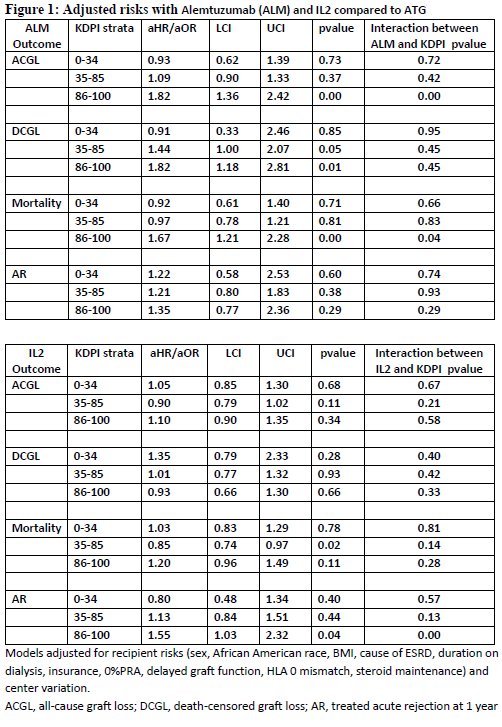Induction Therapy in Low Risk Elderly Kidney Transplant Recipients: Donor Factors.
Johns Hopkins, Baltimore
University of Colorado, Denve
Meeting: 2017 American Transplant Congress
Abstract number: 421
Keywords: Elderly patients, Induction therapy, Kidney, Outcome
Session Information
Session Name: Concurrent Session: Kidney Immunosuppression: Induction Therapy
Session Type: Concurrent Session
Date: Tuesday, May 2, 2017
Session Time: 2:30pm-4:00pm
 Presentation Time: 3:06pm-3:18pm
Presentation Time: 3:06pm-3:18pm
Location: E354b
It is not known whether depleting induction is needed in low-risk elderly kidney transplant (KT) recipients in whom concern for infectious and complications is higher and the impact of donor factors remains unclear. We aimed to compare outcomes of ATG versus IL-2 receptor antagonists or Alemtuzumab (ALEM) in low-risk elderly KT, stratified by KDPI.
METHODS: Using SRTR data 2003-2014 on 7,041 low-risk 65+ years old (first-time, KT alone, PRA<20%, negative HIV/HCV, CIT<24h) deceased-donor KT recipients who received ATG, IL2 or ALEM induction, and Tacrolimus and Mycophenolate with and without steroid. We built Cox models for all-cause graft loss (ACGL), death-censored graft loss (DCGL) and mortality, and regression for treated acute rejection at 1 year (AR). KDPI was categorized: low 0-34, moderate 35-85, high 86+ [table1]RESULTS: Compared to ATG, ALEM and IL2 in low-KDPI were not associated with a difference in ACGL (aHR=0.620.931.39, p=0.7 and 0.851.051.30, p=0.7), DCGL (aHR=0.330.912.46, p=0.9 and 0.0.791.352.33, p=0.4), mortality (aHR=0.610.921.40, p=0.7 and 0.831.031.29, p=0.8), or AR (aOR= 0.581.222.53, p=0.7 and 0.480.801.34, p=0.6). In moderate-KDPI, ALEM and IL2 were not associated with a difference in ACGL (aHR=0.901.091.33, p=0.4 and 0.790.901.02, p=0.2), DCGL (aHR=0.991.442.07, p=0.4 and 0.771.011.32, p=0.4), mortality (aHR=0.780.971.21, p=0.8 and 0.740.850.97, p=0.1), or AR (aOR= 0.801.211.83, p=0.9 and 0.841.131.51, p=0.13). In high-KDPI, ALEM was associated with increased risk of ACGL and mortality (aHR= 1.361.822.42, p=0.00 and 1.211.672.28, p=0.04), but not DCGF (aHR= 1.181.822.82, p=0.4) or AR (aHR= 0.771.352.36, p=0.3); IL2 was not associated with a difference in ACGL, DCGF, or mortality (aHR=0.901.101.35, p=0.6, 0.660.931.30, p=0.3 or 0.961.201.49, p=0.3) but increased risk of AR (aOR= 1.031.552.32, p=0.00).  CONCLUSION: In high KDPI, ALEM was associated with inferior long-term outcomes compared to ATG, while IL2 was associated with higher risk of AR. In low risk elderly KT, IL2 might be the preferred induction therapy in low and moderate-KDPI but ATG in the high-KDPI.
CONCLUSION: In high KDPI, ALEM was associated with inferior long-term outcomes compared to ATG, while IL2 was associated with higher risk of AR. In low risk elderly KT, IL2 might be the preferred induction therapy in low and moderate-KDPI but ATG in the high-KDPI.
CITATION INFORMATION: Al Ammary F, DeMarco M, Huang Q, King E, Bay S, Muzaale A, Wiseman A, Segev D. Induction Therapy in Low Risk Elderly Kidney Transplant Recipients: Donor Factors. Am J Transplant. 2017;17 (suppl 3).
To cite this abstract in AMA style:
Ammary FAl, DeMarco M, Huang Q, King E, Bay S, Muzaale A, Wiseman A, Segev D. Induction Therapy in Low Risk Elderly Kidney Transplant Recipients: Donor Factors. [abstract]. Am J Transplant. 2017; 17 (suppl 3). https://atcmeetingabstracts.com/abstract/induction-therapy-in-low-risk-elderly-kidney-transplant-recipients-donor-factors/. Accessed January 2, 2026.« Back to 2017 American Transplant Congress
